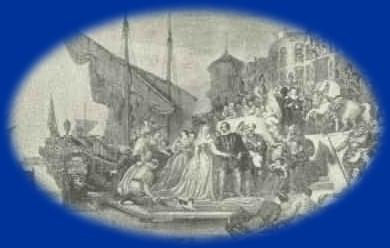|
THE
HISTORY OF LEITH
|
|
|
|
|
|
So who was Mary, Queen of Scots who after the death of Francis II on the 5th December 1560 set sail for Scotland? A country she hadnít seen for almost thirteen years and which had changed so much in that time. Mary was born on the 7th of December in 1542 at Linlithgow Palace and was the daughter of James V and Mary of Guise. James V died on 14th December and was pronounced Queen while only a week old. To Henry VIII this was a Godsend and he tried to arrange a marriage with Mary with the Scottish Parliament to his son Edward. The Scots played along with this until they realised how serious the position was after the Battle of Pinkie, which was fought at Musselburgh in 1547, and which led to the annihilation of the Scottish army. So in return for French help the treaty of Haddington and the young Mary, Queen of Scots was taken to France where she later married the son of Henry II in 1558. However after the death of her husband she lost power in France to her Brother in Law Charles who become Charles IX. Henry II having died in 1559. The Choice was to stay in France where she had lost power or to return to Scotland as Queen. Which on the death of her husband in 1560 she decides to return to Scotland. So on the 19th of August 1561 she arrives in Leith two days early. So on Tuesday morning the weather was bad when Mary arrived. Nothing had been arranged for her, her Uncles of the house of Guise or her servants the famous four Maryís who sounded more French than Scotís. According to John Knox she stayed at Lambís House which if true means that Mary de Guise (her mother) never had a Palace in Leith. The House stands in what is now Burgess St and faces Water St. Water St is supposed to have got its name from a William Waters who lived in the 18th century of whom nothing is known and no tradition is preserved The story of Mary, Queen of Scots is well known and happened in the main outside of Leith. However he her two main achievements in Leith was the granting of a Royal Charter to Trinity House in 1566 and the building of the Leith Tolbooth. She was very anxious to please the people of Leith mainly to keep their support and when they requested for a Tolbooth to be built. This angered the Town council of Edinburgh as they seen it as a threat to their power to control and after she had written several letters which had all been ignored. She finally wrote To the Provost, Baillies and Counsale of Edinburgh: Forasmeikle as we have sent our requiste sundry times to you, to permit the inhabitants of out town of Leith to big and edifie ane hous of justice within the samyn, and has received no answer from you, and so the work is steyit and cessit in your default, Wherefore we charge you, that ye permit our said town of Leith to big and edifie ane said hous of justice within our said town of Leith, and make no stop or impediment to them to do the samyn; for it is our will that the samyn be biggit, and that ye desist from further molesting them in time coming,as we will answer to as thereupon. Subscribit with our hand at Holyrood House the Ist day of March, this year of God 1563. Marie R.Ē This letter had the desired effect and within two years the Tolbooth was built and was demolished in 1819 and replaced with a new Tolbooth in 1822 to a lower standard. It is from the original Tolbooth that of course Tolbooth Wynd got its name. If you think about it people are not neutral about her even today. She is a saint or a sinner. A rabid Papist wanting to bring Scotland back to the Catholic fold or a martyr to what she held to be true, and was completely innocent of any wrong doing for which she died at the age of 44 on the 8th February 1587 at Fotheringhay Castle (which was later demolished by her son James VI (I)) Her lasting achievement was through her son, which put a Scottish King onto the throne of England and created Great Britain on the death of Elizabeth I in 1603. Next month the return of Civil war in Scotland between the Kings men and the Queens men, battles fought between Leith and Edinburgh, and how in a way Leith won after running battles were fought over what is going to be Easter Road and Leith Walk in the future. |
|

